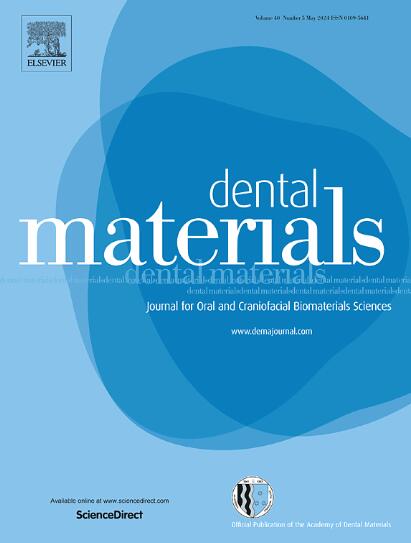Preparation and characterization of mechanical properties of boron nitride nanosheets (BNNSs)-reinforced resin-matrix ceramics for dentistry
IF 6.3
1区 医学
Q1 DENTISTRY, ORAL SURGERY & MEDICINE
引用次数: 0
Abstract
Objective
To evaluate mechanical properties and wear resistance of resin-matrix ceramics reinforced with mechanically produced boron nitride nanosheets (BNNSs)
Materials and methods
BNNSs were dispersed using a mechanical ball-milling technique and incorporated into resin-matrix ceramics at 0.3 %, 0.5 %, 0.7 %, and 0.9 % (wt%). Three-point flexural strength, microhardness, and fracture toughness of the materials were assessed to evaluate the mechanical properties of the resin-matrix ceramics, evaluating the optical properties of resin-matrix ceramics by measuring transmittance, while the wear coefficient and wear rate were measured to determine their wear characteristics. Scanning electron microscopy was employed to analyze the fracture toughness tested sections and wear test surfaces.
Results
Mechanical properties, transmittance, and wear were differently affected by different concentrations of BNNSs. Flexural strength and microhardness were higher at 0.5 wt% BNNSs group, which increased by 18.04 % and 19.8 % respectively when compared with the control group. While fracture toughness increased as BNNSs concentration also increased. Under the condition of 0.9 wt% BNNSs group, the value is larger, which increased by 73.3 % compared to the control group. The transmittance decreased with the addition of BNNSs, with the 0.9 wt% BNNSs group exhibiting a 22.49 % reduction compared to the control group. At 0.5 % BNNSs group, the wear rate was comparatively low, which was 31 % lower than that of the control group. At 0.5 wt% BNNSs group, the wear coefficient is the smallest, at 0.42. SEM analysis suggested that BNNSs reduced the peeling of the filler.
Significance
This study provides an opportunity for the application of nanotechnology in the mechanical properties of resin-matrix ceramics and has the potential to contribute to a new generation of restorative materials in clinical treatment.
牙科用氮化硼纳米片增强树脂基陶瓷的制备及力学性能表征。
目的:研究机械制备氮化硼纳米片(BNNSs)增强树脂基陶瓷的力学性能和耐磨性。材料与方法:采用机械球磨技术将BNNSs分散,并以0.3 %、0.5 %、0.7 %和0.9 % (wt%)加入树脂基陶瓷中。通过测量材料的三点抗弯强度、显微硬度和断裂韧性来评价树脂基陶瓷的力学性能,通过测量透光率来评价树脂基陶瓷的光学性能,通过测量磨损系数和磨损率来确定其磨损特性。采用扫描电镜对断裂韧性测试断面和磨损测试表面进行了分析。结果:不同浓度的BNNSs对材料的力学性能、透光率和磨损有不同的影响。0.5 wt% BNNSs组的抗弯强度和显微硬度较高,分别比对照组提高18.04 %和19.8 %。断裂韧性随BNNSs浓度的增加而增加。在0.9 wt%的BNNSs组条件下,该值较大,比对照组增加了73.3 %。随着BNNSs的加入,透光率降低,与对照组相比,0.9 wt% BNNSs组的透光率降低了22.49 %。在0.5 % BNNSs组,磨损率较低,比对照组低31 %。在0.5 wt% BNNSs组,磨损系数最小,为0.42。SEM分析表明,BNNSs减少了填料的剥落。意义:本研究为纳米技术在树脂基陶瓷力学性能中的应用提供了机会,并有可能为临床治疗中的新一代修复材料做出贡献。
本文章由计算机程序翻译,如有差异,请以英文原文为准。
求助全文
约1分钟内获得全文
求助全文
来源期刊

Dental Materials
工程技术-材料科学:生物材料
CiteScore
9.80
自引率
10.00%
发文量
290
审稿时长
67 days
期刊介绍:
Dental Materials publishes original research, review articles, and short communications.
Academy of Dental Materials members click here to register for free access to Dental Materials online.
The principal aim of Dental Materials is to promote rapid communication of scientific information between academia, industry, and the dental practitioner. Original Manuscripts on clinical and laboratory research of basic and applied character which focus on the properties or performance of dental materials or the reaction of host tissues to materials are given priority publication. Other acceptable topics include application technology in clinical dentistry and dental laboratory technology.
Comprehensive reviews and editorial commentaries on pertinent subjects will be considered.
 求助内容:
求助内容: 应助结果提醒方式:
应助结果提醒方式:


